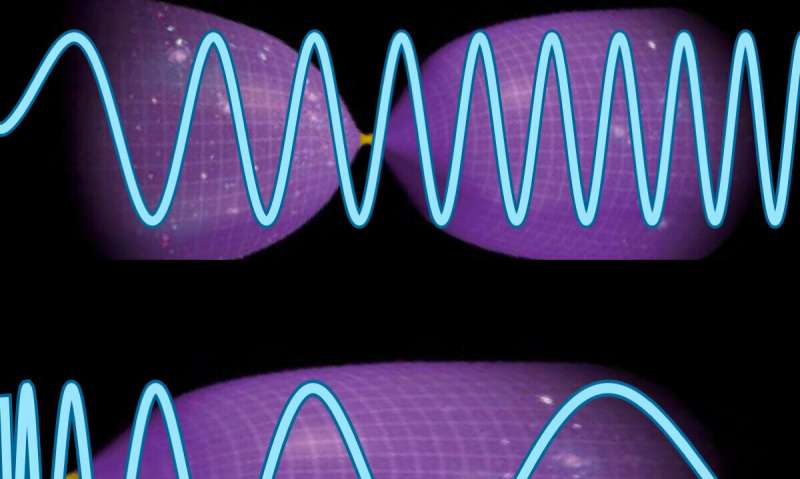What happened before the Big Bang?

A team of scientists has proposed a powerful new test for inflation, the theory that the universe dramatically expanded in size in a fleeting fraction of a second right after the Big Bang. Their goal is to give insight into a long-standing question: what was the universe like before the Big Bang?
Although cosmic inflation is well known for resolving some important mysteries about the structure and evolution of the universe, other very different theories can also explain these mysteries. In some of these theories, the state of the universe preceding the Big Bang – the so-called primordial universe – was contracting instead of expanding, and the Big Bang was thus a part of a Big Bounce.
To help decide between inflation and these other ideas, the issue of falsifiability – that is, whether a theory can be tested to potentially show it is false – has inevitably arisen. Some researchers, including Avi Loeb of the Center for Astrophysics | Harvard & Smithsonian (CfA) in Cambridge, Mass., have raised concerns about inflation, suggesting that its seemingly endless adaptability makes it all but impossible to properly test.
"Falsifiability should be a hallmark of any scientific theory. The current situation for inflation is that it's such a flexible idea, it cannot be falsified experimentally," Loeb said. "No matter what value people measure for some observable attribute, there are always some models of inflation that can explain it."
Now, a team of scientists led by the CfA's Xingang Chen, along with Loeb, and Zhong-Zhi Xianyu of the Physics Department of Harvard University, have applied an idea they call a "primordial standard clock" to the non-inflationary theories, and laid out a method that may be used to falsify inflation experimentally. The study will appear in Physical Review Letters as an Editors' Suggestion.
In an effort to find some characteristic that can separate inflation from other theories, the team began by identifying the defining property of the various theories – the evolution of the size of the primordial universe.
"For example, during inflation, the size of the universe grows exponentially," Xianyu said. "In some alternative theories, the size of the universe contracts. Some do it very slowly, while others do it very fast.
"The attributes people have proposed so far to measure usually have trouble distinguishing between the different theories because they are not directly related to the evolution of the size of the primordial universe," he continued. "So, we wanted to find what the observable attributes are that can be directly linked to that defining property."
The signals generated by the primordial standard clock can serve such a purpose. That clock is any type of heavy elementary particle in the primordial universe. Such particles should exist in any theory and their positions should oscillate at some regular frequency, much like the ticking of a clock's pendulum.
The primordial universe was not entirely uniform. There were tiny irregularities in density on minuscule scales that became the seeds of the large-scale structure observed in today's universe. This is the primary source of information physicists rely on to learn about what happened before the Big Bang. The ticks of the standard clock generated signals that were imprinted into the structure of those irregularities. Standard clocks in different theories of the primordial universe predict different patterns of signals, because the evolutionary histories of the universe are different.
"If we imagine all of the information we learned so far about what happened before the Big Bang is in a roll of film frames, then the standard clock tells us how these frames should be played," Chen explained. "Without any clock information, we don't know if the film should be played forward or backward, fast or slow, just like we are not sure if the primordial universe was inflating or contracting, and how fast it did so. This is where the problem lies. The standard clock put time stamps on each of these frames when the film was shot before the Big Bang, and tells us how to play the film."
The team calculated how these standard clock signals should look in non-inflationary theories, and suggested how they should be searched for in astrophysical observations. "If a pattern of signals representing a contracting universe were found, it would falsify the entire inflationary theory," Xianyu said.
The success of this idea lies with experimentation. "These signals will be very subtle to detect," Chen said, "and so we may have to search in many different places. The cosmic microwave background radiation is one such place, and the distribution of galaxies is another. We have already started to search for these signals and there are some interesting candidates already, but we need more data."
Many future galaxy surveys, such as US-lead LSST, European's Euclid and the newly approved project by NASA, SphereX, are expected to provide high quality data that can be used toward the goal.
The preprint of this paper is available in: arxiv.org/abs/1809.02603 . A related previous work can be found in: arxiv.org/abs/1509.03930 .
More information: Unique Fingerprints of Alternatives to Inflation in the Primordial Power Spectrum, arXiv:1809.02603 [astro-ph.CO] arxiv.org/abs/1809.02603
Xingang Chen et al. Unique Fingerprints of Alternatives to Inflation in the Primordial Power Spectrum, Physical Review Letters (2019). DOI: 10.1103/PhysRevLett.122.121301 , journals.aps.org/prl/abstract/ … ysRevLett.122.121301
Journal information: Physical Review Letters
Provided by Harvard-Smithsonian Center for Astrophysics




















